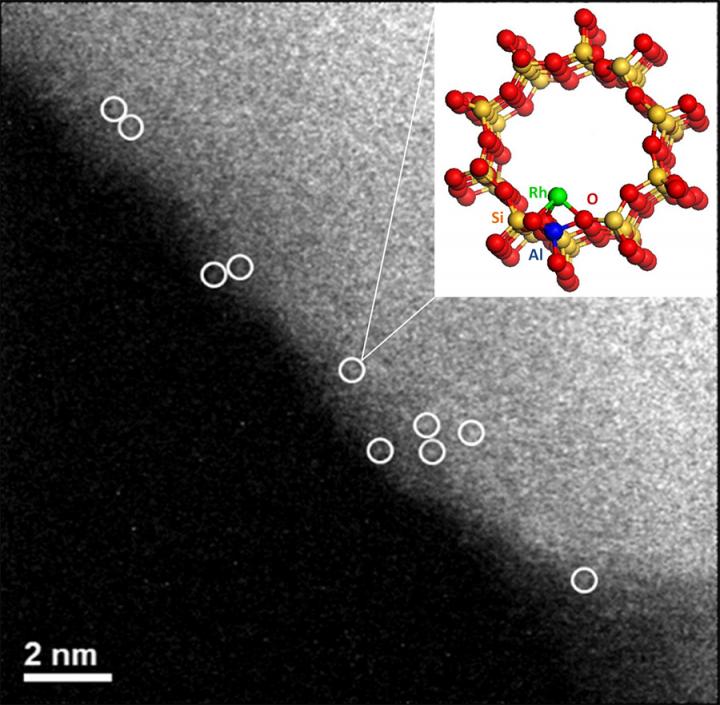Making fuel out of thick air

The researchers gained new insights into the atomic-scale structure of rhodium-based catalysts. Image courtesy of Lawrence F. Allard and Oak Ridge National Laboratory
In a new study, researchers at the U.S. Department of Energy's (DOE) Argonne National Laboratory, Tufts University and Oak Ridge National Laboratory teamed up to explore the potential of rhodium-based catalysts for this conversion under milder conditions.
“Our work shows the potential of rhodium to enable this conversion under 'mild conditions' such as lower temperatures,” said Argonne X-ray scientist Sungsik Lee. “Converting methane to methanol under mild conditions could have significant applications and present a breakthrough in catalysis.”
“Our work shows the potential of rhodium to enable this conversion under 'mild conditions' such as lower temperatures.” – Sungsik Lee, Argonne X-ray scientist
Methanol is a key feedstock for the production of chemicals, some of which are used to make products such as plastics, plywood and paints. Methanol also could potentially fuel vehicles or be reformed to produce high grade hydrogen for fuel cells.
The decades-long interest in finding efficient ways to convert methane to methanol has grown even stronger in recent years thanks to the abundance of methane found in U.S.-based natural gas.
However, the current method for producing methanol from methane involves a multi-step process that is neither efficient nor economical in small-scale applications.
In the study, published in Nature, the researchers developed a new way of converting methane to methanol using rhodium and tested the effectiveness of rhodium catalysts under varying conditions. The catalysts, prepared using relatively simple procedures, were used to better convert methane to methanol and acetic acid using oxygen (O2) and carbon monoxide (CO) under mild conditions.
“The direct conversion of methane to liquid methanol has been an unsolved problem in catalysis,” said Lee. “Through the use of various testing facilities, including Argonne's Advanced Photon Source, we were able to provide new insights into the atomic-scale structure of these noble catalysts, which are atomically dispersed rhodium complexes rather than nanoparticles.”
In a commentary in Nature, based on the study, Ive Hermans, chemistry professor at the University of Wisconsin-Madison, noted that the research “links homogeneous organometallic chemistry … with solid-phase (heterogeneous) catalysis, and illustrates the importance of understanding catalysts at the atomic scale.”
In the study, the research team suggested that further research and testing will illuminate the mechanism and reaction pathways that will guide new methane conversion catalyst design.
“While our work is still far from commercial application, it may inspire research directions for new methane-converting catalysts,” said Lee.
###
The Nature paper is titled “Mild oxidation of methane to methanol or acetic acid on supported isolated rhodium catalysts.” Argonne's Advanced Photon Source is a DOE Office of Science User Facility. The research was funded by DOE's ARPA-E program.
Argonne National Laboratory seeks solutions to pressing national problems in science and technology. The nation's first national laboratory, Argonne conducts leading-edge basic and applied scientific research in virtually every scientific discipline. Argonne researchers work closely with researchers from hundreds of companies, universities, and federal, state and municipal agencies to help them solve their specific problems, advance America's scientific leadership and prepare the nation for a better future. With employees from more than 60 nations, Argonne is managed by UChicago Argonne, LLC for the U.S. Department of Energy's Office of Science.
The U.S. Department of Energy's Office of Science is the single largest supporter of basic research in the physical sciences in the United States and is working to address some of the most pressing challenges of our time. For more information, visit the Office of Science website.
Media Contact
All latest news from the category: Life Sciences and Chemistry
Articles and reports from the Life Sciences and chemistry area deal with applied and basic research into modern biology, chemistry and human medicine.
Valuable information can be found on a range of life sciences fields including bacteriology, biochemistry, bionics, bioinformatics, biophysics, biotechnology, genetics, geobotany, human biology, marine biology, microbiology, molecular biology, cellular biology, zoology, bioinorganic chemistry, microchemistry and environmental chemistry.
Newest articles

NASA: Mystery of life’s handedness deepens
The mystery of why life uses molecules with specific orientations has deepened with a NASA-funded discovery that RNA — a key molecule thought to have potentially held the instructions for…

What are the effects of historic lithium mining on water quality?
Study reveals low levels of common contaminants but high levels of other elements in waters associated with an abandoned lithium mine. Lithium ore and mining waste from a historic lithium…

Quantum-inspired design boosts efficiency of heat-to-electricity conversion
Rice engineers take unconventional route to improving thermophotovoltaic systems. Researchers at Rice University have found a new way to improve a key element of thermophotovoltaic (TPV) systems, which convert heat…



